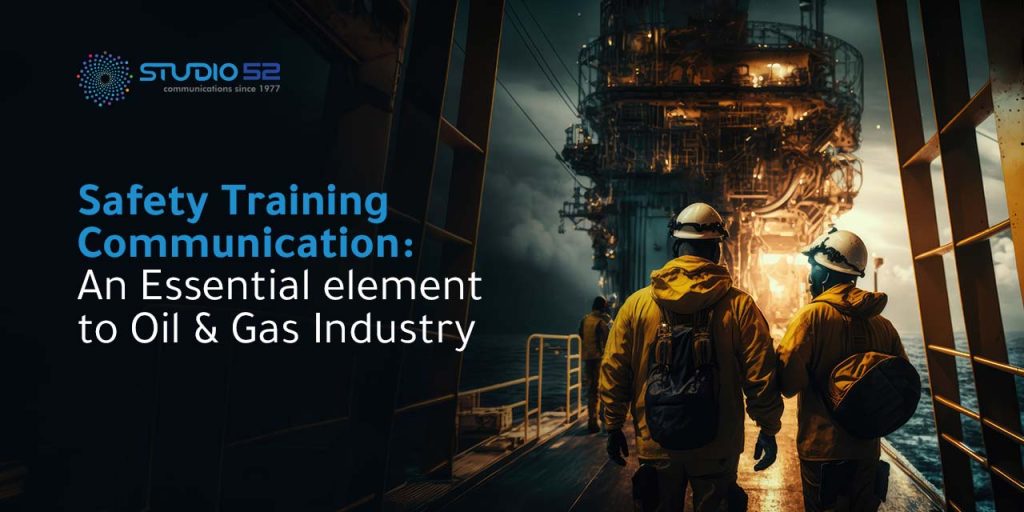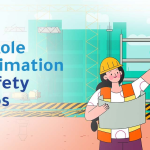Hazards are prevalent problems in the oil and gas business. One article says human factors cause some of the most serious accidents in this industry.
Oil and Gas is one of the most dangerous industries due to the complexity of its operations. Workers are involved in petroleum exploration, drilling, transportation, and refining. There are numerous risks associated with these operations, including well blowouts, equipment failures, pipeline spills, and accidents. Thus, it is extremely vital to take precautions against the safety complexities in the industry.
Keep Your Safety Modules Up-To-Date. Contact Us for Comprehensive Safety Videos.
Safety training is essential to promote a safe working environment. In this blog, we will discuss the necessity of safety training in the oil and gas industry.
The Role of Safety Training in the Oil & Gas Sector
Studies show such high-risk industries account for three out of every five deaths in the United States – primary causes being workers getting entangled in forklifts, cranes, or hoists. To avoid such fatalities, every industry in the sector must provide safety training to its workforce.
- Protecting the lives of the workers
Efficient safety training ensures that personnel are prepared to handle emergencies on-site. You must provide the necessary training to help the crew run machinery efficiently and manage hazardous items. They should also know how to use emergency equipment. This includes fire extinguishers, eyewash stations, and emergency showers. In doing so, you can provide them the key steps to take in emergencies and help them save their own and their colleagues’ lives.
- Compliance with industry regulations and standards
Complying with industry rules and standards requires following rigid frameworks and regulations. These include OSHA (Occupational Safety and Health Administration) requirements and other standards for your location. Safety training ensures your workers have the essential knowledge to carry out protocols and processes to meet these safety standards.
- Creating a safety culture within the organisation
Safety training modules contribute to developing a workplace culture based on shared values, attitudes, and practices that prioritise safety. It encourages employees to actively participate in reporting incidents, identifying potential dangers and preventative measures, and taking initiatives to improve safety.
Safety training empowers workers to reduce risks. It also fosters a culture of following safety rules in the facility. Elevate Your Safety Training Module With Safety Videos — Consult Our Experts Today!
Advantages of Safety Videos in Oil and Gas Industry Training
Safety videos have emerged as reliable safety training methods. More and more oil and gas organisations have incorporated them in their safety modules to make their training highly engaging. Safety videos also have other benefits like increased visual impact, consistency, and scalability, along with greater accessibility and flexibility. Let’s discuss these advantages in depth.
- Visual impact and engagement
Incorporate real-life examples into the film to highlight safe procedures. It increases retention and engagement as compared to written lessons. Also, safety videos capture workers’ attention. They explain safety measures in an easy-to-remember format. For example, a safety video could show chemical handling and spill response protocols. You can show how to store things properly, how to move things safely and the importance of wearing PPE kits. You may also show a spill simulation and the urgent steps to ensure safety.
- Consistency and scalability in training programs
Everyone must follow some protocols in the oil and gas industry, no matter where they work. One such protocol is the usage of personal protection equipment. You can make a video about fire-resistant clothes. It can cover safety helmets, gloves, and eye protection. It should also cover how to wear them for safety correctly. You can share the recorded video across numerous training sessions, increasing scalability. The videos provide training of consistent value to all departments. This results in efficient safety communication.
- Better Accessibility and Flexibility
Safety videos provide more accessibility in terms of safety training. It enables workers to access training modules remotely and complete safety training independently. You can also include interactive quizzes based on safety instruction videos to improve retention. Workers can view these safety videos on their phones. This makes them more accessible and flexible. You can boost access and efficiency by making safety videos in many languages. This will ensure everyone understands them.
To make safety training videos better, use tailored modules. First, understand the industry’s specific needs. Then, include industry terminology in the video and customise content for different roles. In the next section, let’s discuss this customisation in detail.
Tailoring Safety Videos for the Oil & Gas Industry
Making safety videos specifically for the organisation significantly enhances workplace safety. For example, in the video, you can display fire extinguishers at their exact locations. These practices make safety videos more relevant as they provide practical and consistent safety training for your employees.
- Understanding the specific needs of the industry
To create a tailored safety training video, identify operational challenges and dangers. Our experts discuss and compile a list of risks faced by your company on a daily basis and the training required to address them. It is an effective technique to address individual risks with specialised safety training videos. For example, if your site involves a high-pressure operation, you can create a safety training video that covers pressure relief systems and regular equipment inspections.
- Incorporating industry-specific terminology and scenarios
Use industry-specific language and scenarios in your safety training videos. This will make them more relevant and approachable to your employees. For example, workers who work on drilling rigs often use the word “Derrick”. Using that phrase in your safety training video would increase their familiarity. It would also increase their knowledge of the safety procedures. In this situation, create a video showing workers how to react to kicks or gas influxes. This will make the safety training video relevant for everyone in your work crew.
- Customising content for diverse roles within the sector
You can categorise the departments in your workforce. Then, tailor your safety training videos accordingly. This allows workers in specific departments to receive department-specific safety training, saving time and company resources at the same time. For example, you can develop customised safety training videos for field technicians on correct tool use, maintenance, and inspection.
Also Read: The Best Practices for Safety Videos in the Oil and Gas Industry
Conclusion
Adding safety videos to traditional training can help you improve training and make it faster. Safety videos have many benefits. They include higher retention, scalability, and increased accessibility and flexibility. They bridge the communication gap. They give the team the knowledge to keep the workplace safe. It not only protects workers but also benefits the organisation’s long-term reputation.
Safety videos help to train workers effectively and create a safer workplace. Consult Our Experts to Discuss Your Safety Videos Needs. Reach Out Now!
FAQs
1. What are the most common hazards in the oil and gas industry?
Fires and explosions are common risks at oil refineries. If safety precautions are not taken, serious consequences can occur. Machinery and equipment could also pose significant risks in the workplace. Forklifts, for example, can trap or pose physical rise for the workers. There’s also the possibility of becoming entangled in massive gear. The workers who labour on offshore platforms are more likely to slip and fall. Taking preventative actions to avoid fatalities from occurring is critical. You can present some safety measures using safety videos to ensure personnel understand the necessary safety practices and training for emergencies.
2. Why is safety important in the oil and gas industry?
The oil and gas sector involves challenging operations. It includes exploration, drilling, and processing of hydrocarbons. Lack of safety precautions is extremely hazardous for the safety of the crew. They can lead to worker deaths and environmental concerns, as a small leak could cause an explosion. It could also release dangerous substances into the environment. This emphasises the need for workplace safety compliance and adherence to safety rules. You should provide personnel with the necessary training to practise safety in the hazardous workplace. One approach to improve safety training is to use safety training videos. You may use them in your safety training programs to educate employees about workplace safety.
3. How can safety videos improve worker engagement?
Safety videos include animations, visual components, and emergency simulations. This makes it more engaging and relevant for the workers. Visual stimulation ensures that they retain information better than in written formats that require them to read long paragraphs about the importance of following workplace safety rules. These safety videos can be made more interactive by including quizzes. The video could have a segment where viewers are asked to identify the appropriate equipment for various work scenarios. Further, customising the videos in several languages enables their comprehension by a diverse workforce. Thus, a well-executed safety video directly contributes to higher work engagement.





